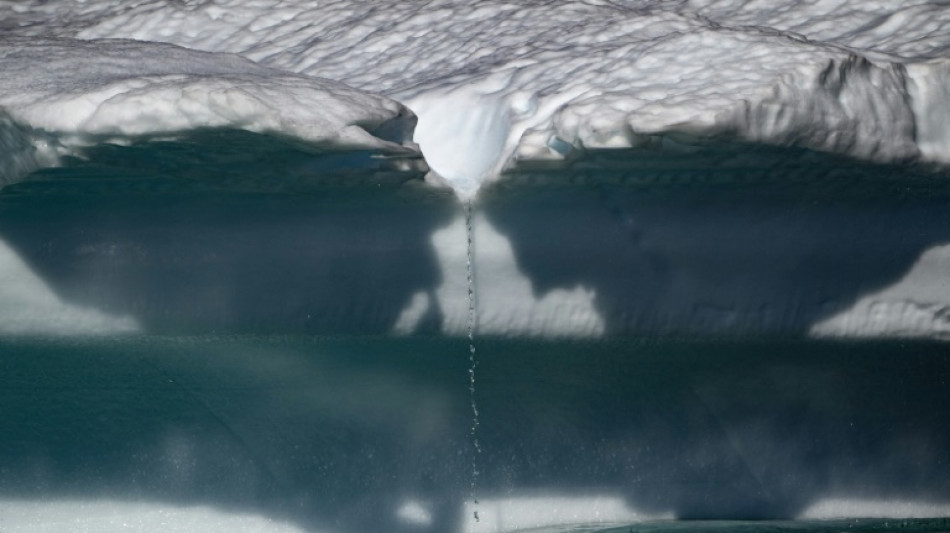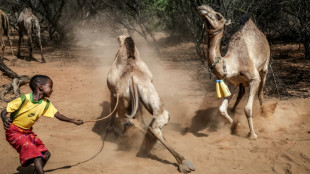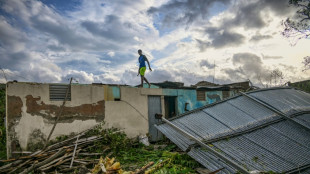
-
 Turkey, Muslim allies say Palestinian self-rule key to Gaza future
Turkey, Muslim allies say Palestinian self-rule key to Gaza future
-
Tens of thousands shelter as typhoon slams into Philippines

-
 Stock markets rise as tech sector buoyed by fresh AI deal
Stock markets rise as tech sector buoyed by fresh AI deal
-
Vitinha says PSG-Bayern Champions League clash will show who's 'best'

-
 Arsenal: The unstoppable Premier League force?
Arsenal: The unstoppable Premier League force?
-
Denmark inaugurates rare low-carbon hydrogen plant

-
 Springboks back Ntlabakanye call-up despite doping probe
Springboks back Ntlabakanye call-up despite doping probe
-
German plans to lower industrial power costs from January

-
 Christian, Muslim Nigerians push back on threatened US strikes
Christian, Muslim Nigerians push back on threatened US strikes
-
Nigeria's Rivers United paired with African champions Pyramids

-
 India women cricketers hail new era but challenges remain
India women cricketers hail new era but challenges remain
-
'Heroic' worker praised as man charged over UK train stabbings

-
 Bangladesh ex-PM Zia to contest elections: party
Bangladesh ex-PM Zia to contest elections: party
-
Tanzania president sworn in as opposition says hundreds killed in protests

-
 India announces $5.75 million reward for women cricket World Cup winners
India announces $5.75 million reward for women cricket World Cup winners
-
Stock markets rise on AI optimism

-
 Spain regional leader resigns, a year after deadly floods
Spain regional leader resigns, a year after deadly floods
-
Video game creators fear AI could grab the controller

-
 France threatens Shein ban if 'childlike' sex dolls reappear
France threatens Shein ban if 'childlike' sex dolls reappear
-
International cricket returns to Faisalabad with Pakistan-South Africa ODIs

-
 Afghan govt says quake kills 20, injures over 500
Afghan govt says quake kills 20, injures over 500
-
'We're all too rich,' says photo legend Martin Parr

-
 Tanzania president inaugurated as opposition says hundreds dead
Tanzania president inaugurated as opposition says hundreds dead
-
Shafali Verma: India's World Cup hero who disguised herself as boy

-
 Most equity markets rise on lingering trader optimism
Most equity markets rise on lingering trader optimism
-
Asian markets rise on lingering trader optimism

-
 Afghanistan quake kills 20, injures over 300: health ministry
Afghanistan quake kills 20, injures over 300: health ministry
-
India hails maiden women's World Cup cricket title as game-changer

-
 As clock ticks down, Greece tries to clean up its act on waste
As clock ticks down, Greece tries to clean up its act on waste
-
Local fabrics, fibres shine at eco-centred Lagos Fashion Week

-
 Spalletti bidding to revive Juve and reputation ahead of Sporting visit in Champions League
Spalletti bidding to revive Juve and reputation ahead of Sporting visit in Champions League
-
Tanzania president to be inaugurated as opposition says hundreds dead

-
 Bouanga brace as LAFC beats Austin 4-1 to advance in MLS Cup playoffs
Bouanga brace as LAFC beats Austin 4-1 to advance in MLS Cup playoffs
-
'Golden age': Japan hails Yamamoto, Ohtani after Dodgers triumph

-
 Thunder roll over Pelicans to remain NBA's lone unbeaten team
Thunder roll over Pelicans to remain NBA's lone unbeaten team
-
Hong Kong legislature now an 'echo chamber', four years after shake-up

-
 Most Asian markets rise on lingering trader optimism
Most Asian markets rise on lingering trader optimism
-
Andrew to lose his last military rank: defence minister

-
 Trump's global tariffs to face challenge before Supreme Court
Trump's global tariffs to face challenge before Supreme Court
-
Barnstorming Bayern face acid test at reigning champions PSG

-
 Alonso shaping new Real Madrid on Liverpool return
Alonso shaping new Real Madrid on Liverpool return
-
Half Yours favourite at Australia's 'race that stops a nation'

-
 Tonga rugby league star has surgery after 'seizure' against NZ
Tonga rugby league star has surgery after 'seizure' against NZ
-
Trent's return with Real Madrid reminds Liverpool of what they are missing

-
 Tehran toy museum brings old childhood memories to life
Tehran toy museum brings old childhood memories to life
-
Iran banking on Iraq vote to retain regional influence

-
 Daughter of 'underground' pastor urges China for his release
Daughter of 'underground' pastor urges China for his release
-
Trump the Great? President steps up power moves

-
 Fire ravages French monastery dubbed 'Notre-Dame of the Ardennes'
Fire ravages French monastery dubbed 'Notre-Dame of the Ardennes'
-
Bills outlast Chiefs while NFL-best Colts fall to Steelers

| RYCEF | 1.24% | 15.34 | $ | |
| SCS | 0.31% | 16.01 | $ | |
| VOD | -5.01% | 11.475 | $ | |
| BTI | 2.61% | 52.56 | $ | |
| GSK | -1% | 46.395 | $ | |
| NGG | -0.72% | 74.71 | $ | |
| AZN | -1.32% | 81.325 | $ | |
| RELX | -0.53% | 44.005 | $ | |
| RBGPF | -3.95% | 76 | $ | |
| CMSC | -0.25% | 23.69 | $ | |
| RIO | -1.71% | 70.535 | $ | |
| BCE | -1.94% | 22.425 | $ | |
| BP | 0.21% | 35.205 | $ | |
| CMSD | -0.38% | 23.9 | $ | |
| JRI | -0.72% | 13.8 | $ | |
| BCC | -2.02% | 69.095 | $ |

Humanity deep in the danger zone of planetary boundaries: study
Human activity and appetites have weakened Earth's resilience, pushing it far beyond the "safe operating space" that keeps the world liveable for most species, including our own, a landmark study said Wednesday.
Six of nine planetary boundaries -- climate change, deforestation, biodiversity loss, synthetic chemicals including plastics, freshwater depletion, and nitrogen use -- are already deep in the red zone, an international team of 29 scientists reported.
Two of the remaining three -- ocean acidification along with the concentration of particle pollution and dust in the atmosphere -- are borderline, with only ozone depletion comfortably within safe bounds.
The planetary boundaries identify "the important processes that keep the Earth within the kind of the living conditions that prevailed over the last 10,000 years, the period when humanity and modern civilisation developed", said lead author Katherine Richardson, a professor at the University of Copenhagen's Globe Institute.
The study is the second major update of the concept, first unveiled in 2009 when only global warming, extinction rates, and nitrogen had transgressed their limits.
"We are still moving in the wrong direction," said co-author Johan Rockstrom, director of the Potsdam Institute for Climate Impact Research (PIK) and a co-creator of the schema.
"And there's no indications that any of the boundaries" -- except the ozone layer, slowly on the mend since the chemicals destroying it were banned -- "have started to bend in the right direction", he told journalists in a briefing.
"This means we are losing resilience, that we are putting the stability of the Earth system at risk."
The study quantifies boundaries for all nine interlocking facets of the Earth system.
- Headed for disaster -
For biodiversity, for example, if the rate at which species disappear is less than 10 times the average extinction rate over the last 10 million years, that is deemed acceptable.
In reality, however, extinctions are occurring at least 100 times faster than this so-called background rate, and 10 times faster than the planetary boundary limit.
For climate change, that threshold is keyed to the concentration of atmospheric CO2, which remained very close to 280 parts per million (ppm) for at least 10,000 years prior to the industrial revolution.
That concentration is today 417 ppm, far above the safe boundary of 350 ppm.
"On climate, we're still following a pathway that takes us unequivocally to disaster," said Rockstrom. "We're headed for 2.5C, 2.6C or 2.7C -- a place we haven't seen for the past four million years."
"There's no evidence whatsoever that humans can survive in that environment," he added.
Thousands upon thousands of chemical compounds created by humans -- from micro-plastics and pesticides to nuclear waste and drugs that have leached into the environment -- were quantified for the first time in the new research, and found to exceed safe limits.
Likewise for the depletion of "green" and "blue" water, freshwater coming from soil and plants on the one hand, and from rivers and lakes on the other.
- Setting limits -
An important finding of the new update is that different boundaries feed off and amplify each other.
The study examines in particular the interaction between increasing CO2 concentration and damage to the biosphere, especially forest loss, and projects temperature increases when one or both increase.
It shows that even if humanity rapidly draws down greenhouse gas emissions, unless destruction of carbon-absorbing forests is halted at the same time rising global temperatures could tip the planet onto a trajectory of additional warming that would be hard to stop.
"Next to climate change, integrity of the biosphere is the second pillar for our planet," said co-author Wolfgang Lucht, head of Earth System Analysis at PIK.
"We are currently destabilising this pillar by taking out too much biomass, destroying too much habitat, deforesting too much land."
All the boundaries can be brought back into the safe operating space, the study concluded.
"It's just a question of setting limits for the amount of waste we put into the open environment and the amount of living and non-living raw materials we take out," said Richardson.
Hotly debated at first, the planetary boundaries framework quickly became a pillar of Earth system science, with its influence extending today into the realm of policy and even business.
P.Mathewson--AMWN



